What is PoE?
Completed
-
Introduction to PoE
-
PoE in the Standards
-
PoE as Safe Technology
-
Picking the Right PoE
-
Testing Your Knowledge
-
- Join this Course to access resources
- Quiz
-
Using the PoE Specifier's Guide
Using the Specifier's Guide
Now that you know what Power Over Ethernet or PoE is in general terms, you're ready for the first step in specifying Power Over Ethernet, what will you do with PoE.
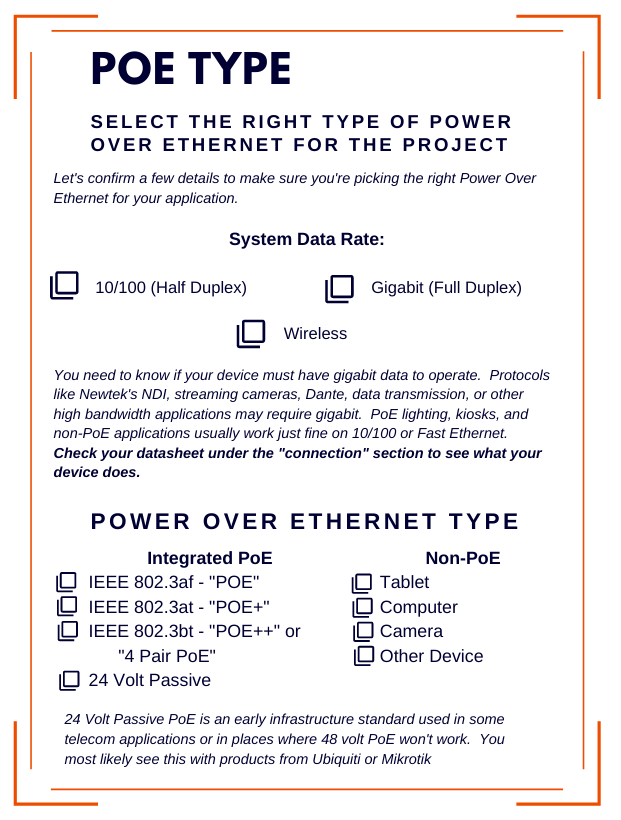
POE Type
First, you need to know what kind of project you’re trying to tackle. That may seem kind of simple like you wouldn’t know what you’re selling to your customers. But knowing which type of project you’re doing whether it’s lighting or wifi or phones, especially if you’re doing a project with multiple types, will help you get the right balance of PoE and networking technology. As we get further along, I think you’ll see how this applies. For now, the key here is to gather the specifications on the products you’re using. These are usually in the form of a datasheet.
For now, I can share with you your first pro tip, how to get your product specifications. Rather than keeping paper copies of all your products floating around, you can simply google “Product Name and datasheet” to bring up a digital copy of the datasheet you’re after.
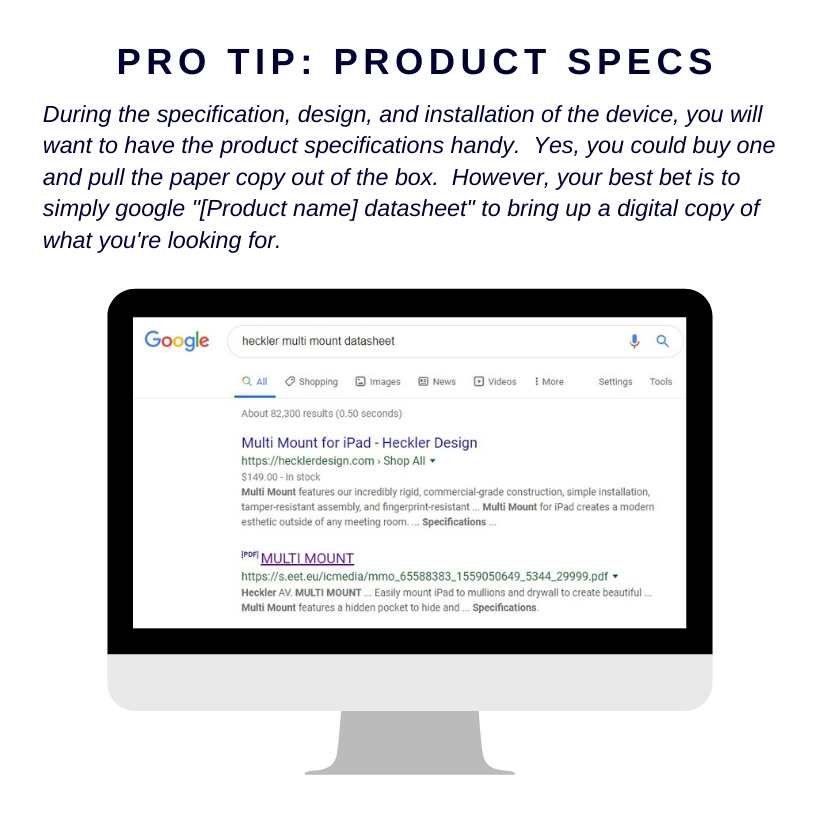
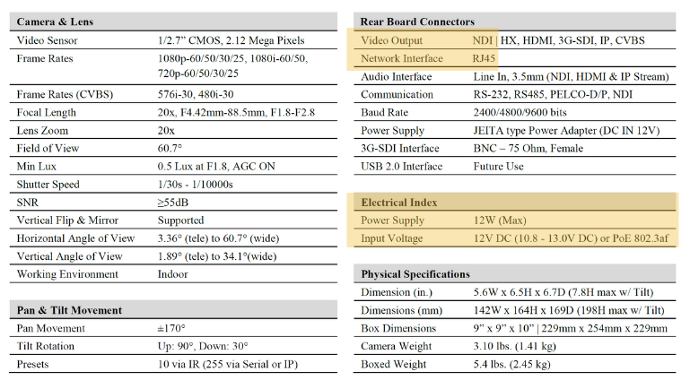
Once you know what product mix you’re using, then you can start picking the right PoE standard to work with, and there are a bunch to choose from. I know you might have heard PoE is PoE is PoE. But there are different PoE standards for different applications and products. There’s even PoE for non-PoE devices like PoE to USB-C or PoE to DC devices.
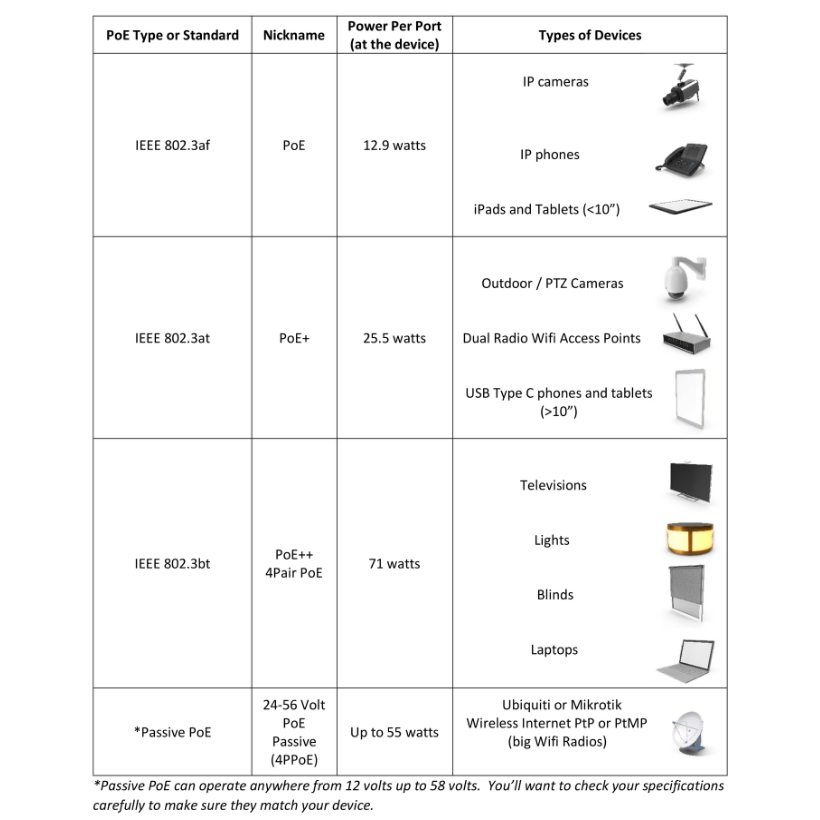
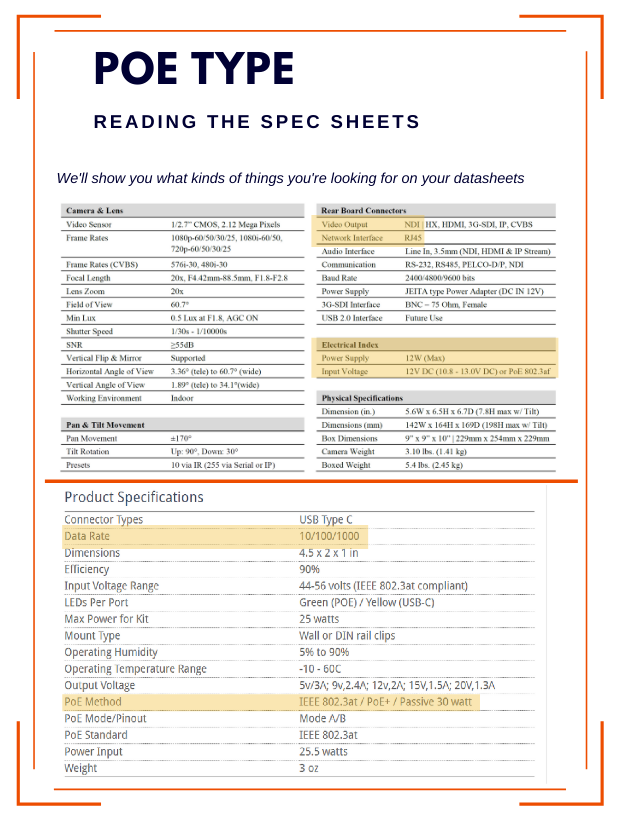
Data Rate
A key question you need to answer first, though, is what type of data do you need? The three most common are 10/100 or half duplex, which really means 100 Megabits per second or Gigabit data or wireless data. I know there’s a lot of hype around the newest and fastest data. Looking at my graphic you’re saying where’s the 10 Gig and 5G. The reality is that very few services and customers need all that data. Let me share a few rules of thumb:
Most IP phones only use on average about 10 megabits
I’ll bet the internet you have at home for streaming your favorite Marvel movie on Disney+ is only 100 Meg
High end production grade cameras use a little more than 100 Meg, so they need gigabit but they don’t use all of it
Wifi access points that are trying to feed data to multiple devices do need the added bandwidth, so they’re gigabit as well
So, double check your datasheet for the actual data rate because you could save a fair amount of money by not wildly over specifying the data. And knowing the data rate will help you pick the PoE switch or injector you need.
Switch vs Injector
Now let’s answer the question of do you pick a PoE switch or Injector. A PoE switch will have one or a couple data uplink ports with multiple ports of power and data out. If you’re installing a new network that doesn’t have special needs, you’ll most likely use a PoE switch.
A midspan or Injector just adds PoE to a data line without affecting the data. These devices are one to one meaning you need a data line in for each PoE line out. These make sense if you already have a switch you want to upgrade to PoE or add more PoE power to. You’ve been there before. You have a network that’s all configured and running flawlessly, but someone needs something that needs more power than your current device can handle. You don’t want to tear up your network to just add PoE. So don’t. Just add an injector.
Or maybe you need a specific switch or router. Rather than compromise your networking needs or pay for something more than you really need, just get the networking device you want and add PoE to it. The Ubiquiti 4 router is the perfect example where the router plus a 4 port Injector costs much less than adding a full PoE switch to the network.
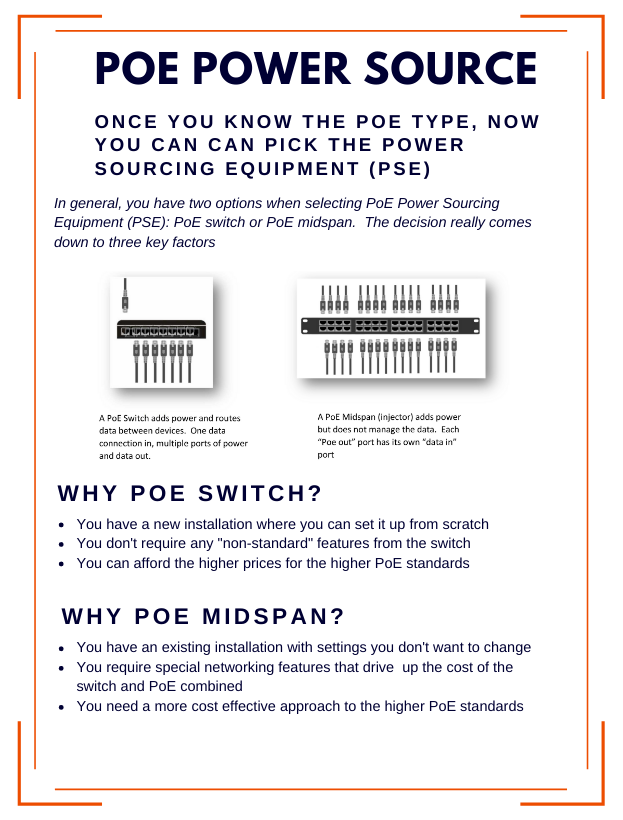
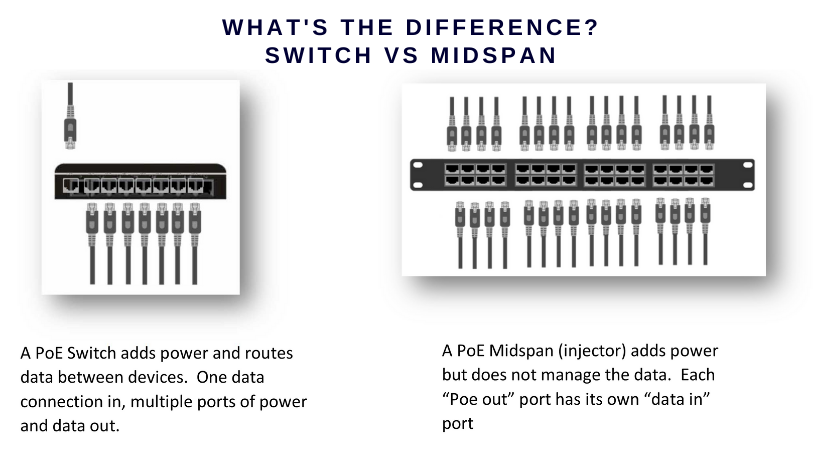

Power Budget
Let’s move on to the power budget. If you haven’t noticed yet, I talk about power . . . a lot. Maybe because it’s even in the name - Power over Ethernet. I’ve talked a lot about watts in this presentation as a measurement of power which really means how much work something can do. Do you remember the table I was talking to earlier about how much power the PoE standards offer? That is the power available on one port of your switch or Injector.
Now we need to talk about your total power budget for your switch or Injector, which is not the same thing as the port power budget. Let’s take a simple example of a four port switch. Let’s say I have a four port PoE+ switch, like this one. That means any one of these four ports can put out 25 watts. I could power an iPad Pro with that. Now let’s assume I put 4x iPad Pro’s each drawing 20 watts of power on each port. 4 times 20 is 80 watts. That would mean I need a total power budget of 80 watts. If my switch only has a 65 watt total power budget, then some of these ports will power off to protect the device giving you unstable results.
As you pick your PoE switch or Injector, you need to look at the total power budget and compare it to the number of devices and the power they draw. We have a table you can fill out to record the power you expect to draw by device and calculate your total power budget.
Cable Power Loss
If your total power need is close to the total power budget of your switch or Injector, you might need to account for cable power losses in your budget. What do I mean by that?
As power, even PoE power, travels down a cable it loses a little power to heat for every foot it travels. So if I have an IP camera that needs 7 watts of power on a cable run of 10 t ft, I may need 9 watts of power on a cable run off 300 ft. For math fans out there the correct calculation is a quadratic equation taking into account power used at the end device, cable properties, and distance.
For everyone who doesn’t have the inclination or time to look up engineering values and do algebraic equation balancing, we have simple calculators where you can plug in a few values and get the answer right away and some recommendations from us on what they mean. You can find our calculator online or in the App Store.
With that now you’re ready to pick the right PoE converters and Power Sourcing Equipment or PSE for your project.

Cable Selection
I do often get asked the question about what cable specifications you should use. I’ll share a few rules of thumb to help you navigate that question. Cables come down to:
how much data do need to send how far?
how much power you need to send?
and where are you putting your cables?
Oh, and how much can you spend?
For real world use, there are the general cable types you need to know, CAT 5e, CAT 6, and CAT 6a.
CAT 5e can handle Gigabit data and PoE+ up to 330 feet. There are special CAT 5e cables with extra thick conductors for high power PoE applications, which work well for lighting and automation and are cheaper than Cat 6.
CAT 6 can handle 10 gig data for short distances and gig up to 330 ft as well as high powered 60 watt or more PoE power. Most customers will request CAT 6 as a standard.
To get 10 gig over any distance you need CAT 6a. It’s the most expensive of the three to install and certify.
Next you need to decide Plenum vs not Plenum vs outdoor cable. I’m sure you know where you’re going outdoors, and I recommend not trying to use indoor cable outside. UV and wet weather require a special type of cable covering, and you might be surprised just how fast indoor cable will wear out if run outside.
So what’s Plenum all about.Plenums are considered spaces in buildings that move air around and can create special fire hazards, so everything in them is designed to be hard to burn and won’t produce as much smoke. You might be surprised to find out where Plenums are. For example many, but not all, drop ceilings are also plenums. If you’re installing cable in a drop ceiling space, it’s a safe bet it’s a Plenum. If you’re going behind sheet rock or in an attic or crawl space, you’re not likely in a Plenum. But you can always ask the owner or architect to confirm.
Finally what about shielded vs unshielded. Shielding protects the data signal from electrical noise. If the cable will be around high voltage electrical, HVAC equipment, or machinery, it’s a safe bet to go shielded. Otherwise, it’s an optional thing for CAT 5e. Most CAT 6 I know is shielded regardless, so that makes the decision easier.
Other Resources
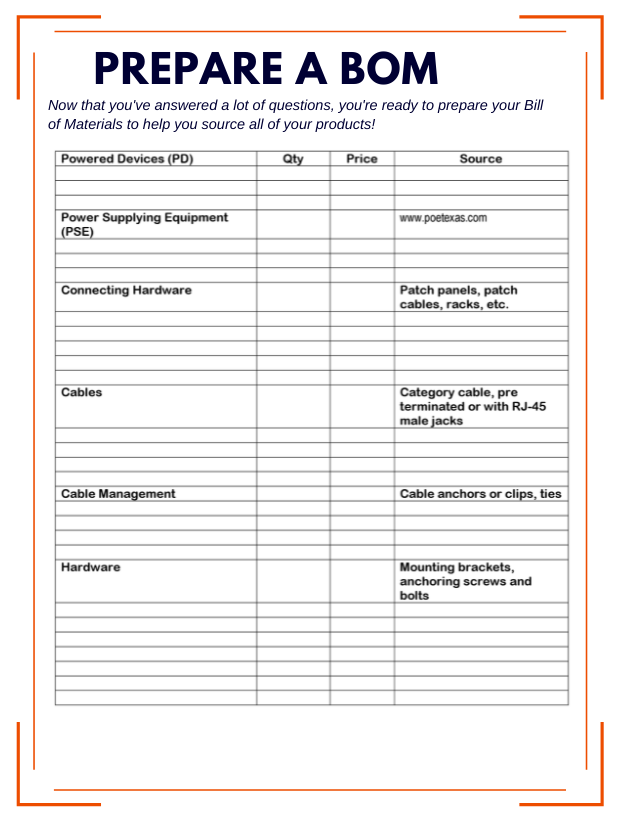
Preparing a BoM
Tool to help you select the material and accessories you need.

Tool Checklist
A reminder on the kinds of tools you shouldn't forget

Power Budget Calculator
How to calculate the per port and for the total switch
Download the package in the next section.
Learn how to get the most out of your PoE by using our Specifier's Guide.
There are no comments for now.